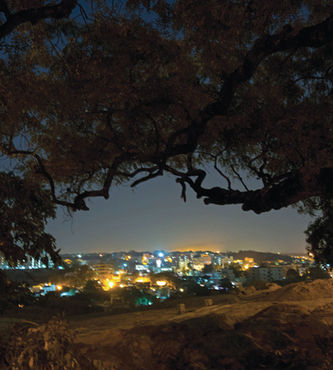'Where are you?' A question grows inside as we step into the darkness of a cold night in this historic city. It is not that we don’t have an answer, but we will let ourselves wander here freely until the answer satisfies us. Who knows anything for sure?



Away from the attention of the thousands of people entering the fort of Golconda through its tall gates, a narrow mud path from a congested suburb leads us to a stone structure. The structure marks the rear border of the fort, from where a natural wall of thick jungle grows west. Standing here, one can have a panoramic view of the city, with its thousands of buildings in luminous colours. Lying not far from this edge, the magnificent tombs of the royals, who had ruled from this fort for centuries, dot the skyline. Shepherds used to camp in this wilderness, where only grass and interspersed rocks remain. On cold nights the shepherds would have rested on these rocks and watched the night sky. Their campfire could have gleamed these rocks. Through the dancing flames, they would have seen the shades of royal tombs. Countless shepherds have come and left. Seasons have changed several times. Time itself has transformed such that it may not even remember its past. The rocks and trees remain undisturbed to date, but they wake up from nightmares these days. A burgeoning human population is knocking at their doors constantly
We stand facing an abandoned concrete structure inside Osmania University. Set up on rocky terrain, this ‘box’ serves many purposes. It acts as a water tank during rain, an informal performance arena for artists during peak summer, and many other unknown roles. Decaying in the coffin of time, this structure marks the thin border which separates the prestigious centre of education from a dark wall of trees. When no humans are nearby, peafowls from the woods occupy the box. Sitting inside it, with a small fire lit up, we watch the shades of buildings on one side and trees on the other. It feels as if the box has dissected the world into two. Will the woods offer us a refuge? Or shall we seek it in the knowledge offered by these buildings?







A series of winding stone steps from a narrow road takes us to the hilltop dargah of Pahadi Shareef. A Sufi saint of medieval times rests here in eternal sleep. The air is silent but for the occasional noises made by aeroplanes. A cool breeze flutters the silk fabric adorning the hundreds of graveyards gazing towards the endless sky. The old trees rising from the rocky ground stand as confidants of the resting souls. Pilgrims and wanderers share the space with the dead, making it the meeting point of the past and present. Sitting amid tombs, we watch the pale green and red dots of flying machines in the night sky. A sense of separation from the city and its millions of citizens pervades us.





Upon a small hillock that nestles Maula Ali Dargah, a blowing wind gradually overpowers the noises from busy streets and speeding vehicles below. On the top, where the rustling of leaves fills the air, a sudden sense of dislocation creeps in us. This island of tranquillity belongs to no one, yet it gives an irresistible pull towards the unknown. Even a speck of grass here can’t resist dancing to the moods of the wind. Sitting on the edge of a rock and looking down, we see a vast sea of humanity floating like ants amid the orange-yellow hue of street lights. How is this space left out of the clutches of earth-movers? Why is it not conquered by steel and concrete? It could be because of the barrier formed by the boulders and the tag of spirituality worn by the space. This serenity may not last long. A concrete road is on the rise to provide easy access to all.
Sandwiched between the past and present, the rural and urban, and the wilderness and human settlements, lies a space that doesn’t belong to either side. Dark wildlands sleep silently on one side of this space, while on the other side, a sea of lights and humanity stays awake. Sitting at these borderlines and looking at the cityscape in the front, we feel the past is closer to us. This past doesn’t belong to us, but we can still ponder it. Exploring these edges at night gives an idea about the two contrasting worlds they separate. With urbanisation progressing rapidly, these thin borders could vanish anytime soon.



















